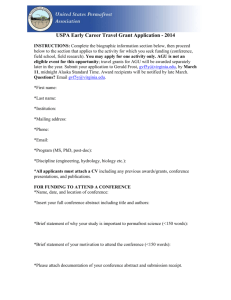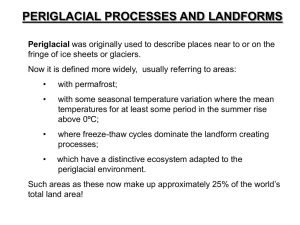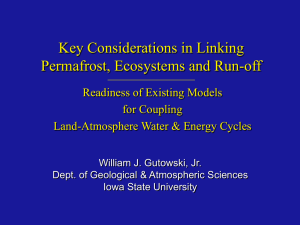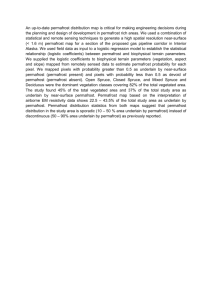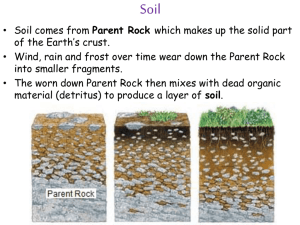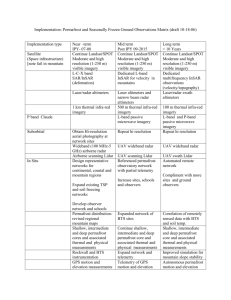Rockglacier acceleration in the Turtmann valley (Swiss Alps): Probable controls
advertisement
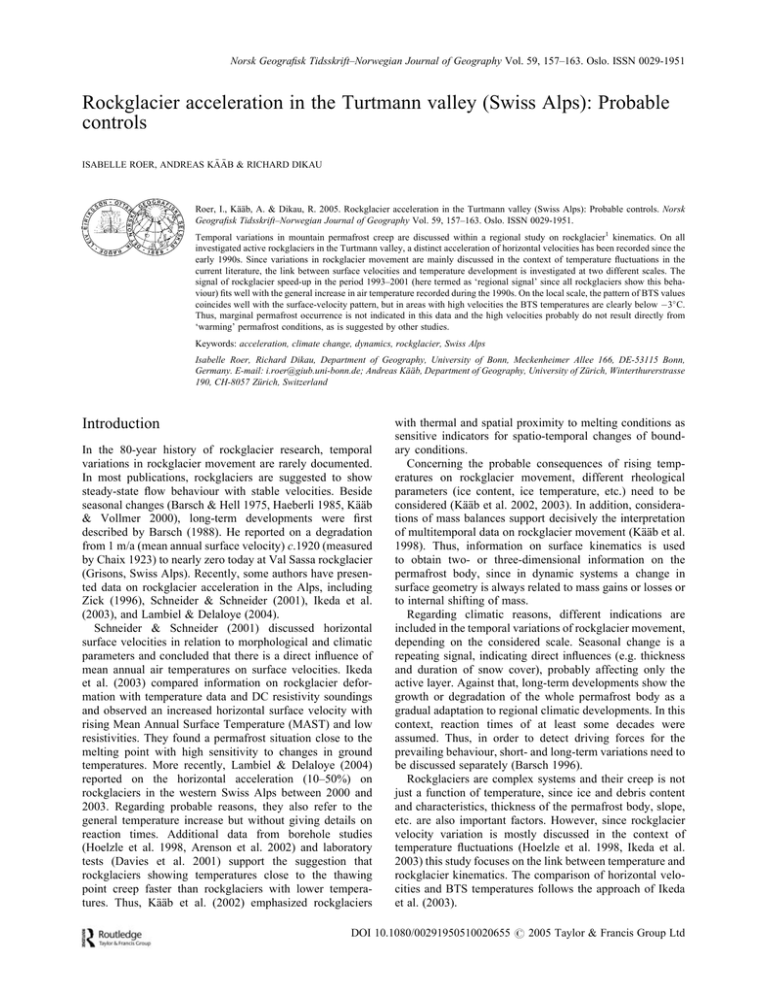
Norsk Geografisk Tidsskrift–Norwegian Journal of Geography Vol. 59, 157–163. Oslo. ISSN 0029-1951 Rockglacier acceleration in the Turtmann valley (Swiss Alps): Probable controls ISABELLE ROER, ANDREAS KÄÄB & RICHARD DIKAU Roer, I., Kääb, A. & Dikau, R. 2005. Rockglacier acceleration in the Turtmann valley (Swiss Alps): Probable controls. Norsk Geografisk Tidsskrift–Norwegian Journal of Geography Vol. 59, 157–163. Oslo. ISSN 0029-1951. Temporal variations in mountain permafrost creep are discussed within a regional study on rockglacier1 kinematics. On all investigated active rockglaciers in the Turtmann valley, a distinct acceleration of horizontal velocities has been recorded since the early 1990s. Since variations in rockglacier movement are mainly discussed in the context of temperature fluctuations in the current literature, the link between surface velocities and temperature development is investigated at two different scales. The signal of rockglacier speed-up in the period 1993–2001 (here termed as ‘regional signal’ since all rockglaciers show this behaviour) fits well with the general increase in air temperature recorded during the 1990s. On the local scale, the pattern of BTS values coincides well with the surface-velocity pattern, but in areas with high velocities the BTS temperatures are clearly below 3 C. Thus, marginal permafrost occurrence is not indicated in this data and the high velocities probably do not result directly from ‘warming’ permafrost conditions, as is suggested by other studies. Keywords: acceleration, climate change, dynamics, rockglacier, Swiss Alps Isabelle Roer, Richard Dikau, Department of Geography, University of Bonn, Meckenheimer Allee 166, DE-53115 Bonn, Germany. E-mail: i.roer@giub.uni-bonn.de; Andreas Kääb, Department of Geography, University of Zürich, Winterthurerstrasse 190, CH-8057 Zürich, Switzerland Introduction In the 80-year history of rockglacier research, temporal variations in rockglacier movement are rarely documented. In most publications, rockglaciers are suggested to show steady-state flow behaviour with stable velocities. Beside seasonal changes (Barsch & Hell 1975, Haeberli 1985, Kääb & Vollmer 2000), long-term developments were first described by Barsch (1988). He reported on a degradation from 1 m/a (mean annual surface velocity) c.1920 (measured by Chaix 1923) to nearly zero today at Val Sassa rockglacier (Grisons, Swiss Alps). Recently, some authors have presented data on rockglacier acceleration in the Alps, including Zick (1996), Schneider & Schneider (2001), Ikeda et al. (2003), and Lambiel & Delaloye (2004). Schneider & Schneider (2001) discussed horizontal surface velocities in relation to morphological and climatic parameters and concluded that there is a direct influence of mean annual air temperatures on surface velocities. Ikeda et al. (2003) compared information on rockglacier deformation with temperature data and DC resistivity soundings and observed an increased horizontal surface velocity with rising Mean Annual Surface Temperature (MAST) and low resistivities. They found a permafrost situation close to the melting point with high sensitivity to changes in ground temperatures. More recently, Lambiel & Delaloye (2004) reported on the horizontal acceleration (10–50%) on rockglaciers in the western Swiss Alps between 2000 and 2003. Regarding probable reasons, they also refer to the general temperature increase but without giving details on reaction times. Additional data from borehole studies (Hoelzle et al. 1998, Arenson et al. 2002) and laboratory tests (Davies et al. 2001) support the suggestion that rockglaciers showing temperatures close to the thawing point creep faster than rockglaciers with lower temperatures. Thus, Kääb et al. (2002) emphasized rockglaciers with thermal and spatial proximity to melting conditions as sensitive indicators for spatio-temporal changes of boundary conditions. Concerning the probable consequences of rising temperatures on rockglacier movement, different rheological parameters (ice content, ice temperature, etc.) need to be considered (Kääb et al. 2002, 2003). In addition, considerations of mass balances support decisively the interpretation of multitemporal data on rockglacier movement (Kääb et al. 1998). Thus, information on surface kinematics is used to obtain two- or three-dimensional information on the permafrost body, since in dynamic systems a change in surface geometry is always related to mass gains or losses or to internal shifting of mass. Regarding climatic reasons, different indications are included in the temporal variations of rockglacier movement, depending on the considered scale. Seasonal change is a repeating signal, indicating direct influences (e.g. thickness and duration of snow cover), probably affecting only the active layer. Against that, long-term developments show the growth or degradation of the whole permafrost body as a gradual adaptation to regional climatic developments. In this context, reaction times of at least some decades were assumed. Thus, in order to detect driving forces for the prevailing behaviour, short- and long-term variations need to be discussed separately (Barsch 1996). Rockglaciers are complex systems and their creep is not just a function of temperature, since ice and debris content and characteristics, thickness of the permafrost body, slope, etc. are also important factors. However, since rockglacier velocity variation is mostly discussed in the context of temperature fluctuations (Hoelzle et al. 1998, Ikeda et al. 2003) this study focuses on the link between temperature and rockglacier kinematics. The comparison of horizontal velocities and BTS temperatures follows the approach of Ikeda et al. (2003). DOI 10.1080/00291950510020655 # 2005 Taylor & Francis Group Ltd 158 I. Roer, A. Kääb & R. Dikau NORSK GEOGRAFISK TIDSSKRIFT 59 (2005) Fig. 1. Rockglacier sequence in the Hungerlitälli, a small hanging valley in the Turtmann valley (the location of the Turtmann valley within Switzerland is indicated in the upper left). A = active, la = inactive, and R = relict rockglacier. The rectangles mark the location of the investigated rockglaciers HuHH1 and HuHH3. Orthophoto taken in August 1975 (# Swiss Federal Office of Topography). Methods Rockglacier creep and its variations were measured by two methods: digital photogrammetry and terrestrial geodetic survey. Depending on the technique applied, different spatial and temporal scales were covered. Due to the availability of aerial photographs, photogrammetric measurements covered the period 1975–2001 and thus provided long-term averages on a large spatial scale. In comparison, geodetic survey delivered high resolution measurements on two single rockglaciers during the years 2001–2004. Detailed information on raw data, single processing steps, and data accuracy is given in Roer et al. (2005). Additionally, a temperature monitoring was started in 2001 using Universal Temperature Loggers (UTL) (Krummenacher et al. 1998). Approximately 45 thermistors were placed in various situations (on rockglaciers and surrounding terrain) between 2500 m a.s.l. and 2780 m a.s.l. in order to compare temperatures on and beyond the permafrost bodies. The resulting data serve to determine the extent of the permafrost occurrence by the calculation of Mean Annual Ground Surface Temperatures (MAGST) as well as the interpretation of the Bottom Temperature of the winter Snow cover (BTS) (M. Nyenhuis, unpublished data). For the latter, the following limiting values were compiled for the Alps (Haeberli 1973, Hoelzle 1992, Hoelzle et al. 1993, 1999, Keller 1994): BTS <3 C = permafrost probable, between 2 C and 3 C = permafrost possible and >2 C = no permafrost. Study area The Turtmann valley is a southern tributary (110 km2) of the river Rhone and is located in southern Switzerland 0 0 (c.46 13 N–7 38 E). The lithology mainly consists of Palaeozoic gneisses and schists of the Penninic SiviezMischabel-nappe (Labhart 1998). The valley’s climate shows a continental character with an annual precipitation of 600–900 mm/a at c.2000 m a.s.l., as well as the 0 C isotherm of the mean annual air temperature (MAAT) at c. 2300 m a.s.l. (Tatenhove & Dikau 1990). The geomorphology of the valley is characterized by the two glaciers, Turtmann and Brunnegg, in the valley head and several hanging valleys above the shoulders of the trough. Here, the periglacial belt is very distinct and typical landforms such as rockglaciers, gelifluction lobes, and ploughing boulders are numerous (Otto & Dikau 2004). The most striking landforms are rockglaciers in all states of activity (Fig. 1). The majority of them are situated close to the lower limit of the discontinuous permafrost, which is estimated at c.2600 m a.s.l., and where MAAT is approximately 1.5 C, as determined by application of regional temperature lapse rates. Results 30 rockglaciers on the east-side of the Turtmann valley were monitored by means of digital photogrammetry. 15 of them showed a distinct activity, and for all of them an increase in horizontal velocity within 26 years of detailed monitoring was ascertained (Fig. 2). The speed-up from period A (1975– 1993) to period B (1993–2001) varied between 16% and 350% on the single rockglaciers. Since the velocities were averaged over the measurement periods of 18 years (1975–1993) and 8 years (1993–2001) respectively, we were not able to date the beginning of the acceleration exactly, but it is likely that it started in the beginning of the 1990s. Persistent high velocities between 2001 and 2004 are NORSK GEOGRAFISK TIDSSKRIFT 59 (2005) Rockglacier acceleration in the Turtmann valley (Swiss Alps) 159 Fig. 2. Comparison of mean annual surface velocities (m/a) of each rockglacier between 1975–1993 (T1) and 1993–2001 (T2), sorted by the altitude of the front (m a.s.l.). confirmed by terrestrial geodetic survey of two active rockglaciers in the Hungerlitälli (Fig. 1). The vertical movement shows no general behaviour and thus is considered only on the local scale. Regarding morphological influences, different terrain parameters were correlated with horizontal displacements (Roer in press). While surface slope and length of the rockglaciers showed no significant correlations, the relation between altitude (of the front) and the mean annual horizontal velocity (1993–2001) revealed a clear correlation. Thus, the influence of air temperature (as a function of altitude) is indicated. Therefore, a link to temperature conditions is investigated on a regional and local scale, respectively. Regional-scale link First, the regional signal of rockglacier acceleration was compared to the general temperature development in the Alps, which has been detailed by Böhm et al. (2001) and Böhm (2003). In homogenized data from c.100 climatic stations in the Alps, Böhm observed a distinct warming trend, starting in 1890 (with two peaks in the 1950s and in the 1990s). Alpine warming since the mid-19th century is twice as high as the global value. Reactions of the high mountain system are described by Böhm (2003), for example in the rise of the 0 C isotherm of c.250 m since 1890 in the western Alps (Monte-Rosa/Mont-Blanc area); 150 m of the total 250 m have occurred in the last 20 years. For the study area, temperature data from the nearby Sion station (c.26 km distant from the Turtmann valley) is given in Fig. 3. In addition to the mean annual temperatures, summer (June–August) and winter (December–February) temperatures are displayed separately. The series indicates a general warming trend since the end of the 19th century. Especially, the strong increase in winter temperatures, from 1.2 C to 0.9 C over the investigated period is depicted in the trendline. Similar trends are also revealed in data from high altitude stations, such as Jungfraujoch (3576 m a.s.l., 40 km distant from the Turtmann valley) and Grosser St. Bernhard (2472 m a.s.l., 65 km distant from the Turtmann valley). The rockglacier speed-up fits well with the general rise in temperature (long time scale) and also with the distinct warming starting in the early 1990s (short time scale). Since rockglacier sensitivity is not known in detail and depends on several parameters, both scales need to be considered. Local-scale link In order to link rockglacier movement to thermal conditions on a local scale, a comparison of horizontal velocities and 160 I. Roer, A. Kääb & R. Dikau NORSK GEOGRAFISK TIDSSKRIFT 59 (2005) Fig. 3. Mean annual air temperatures (black line), mean summer air temperatures (upper grey line) and mean winter air temperatures (lower grey line) at the Sion station (482 m a.s.l.) between 1864 and 2002 (Böhm et al. 2001). The distance to the Turtmann valley is c.26 km. The depicted trendline demonstrates the positive trend of the temperature. BTS values is given in Fig. 4. The rockglacier is 350 m long, c.150 m wide, and the front terminates at 2630 m a.s.l. into permafrost-free terrain. Its surface features are clear ridge-and-furrow topography with an upper lobe overriding the lower one (visible in Figs. 1 and 4b). Between 1975 and 1993 the mean annual horizontal velocity was 0.24 m/a, while it increased to a mean rate of 0.48 m/a between 1993 and 2001. The velocity pattern depicted in Fig. 4a (1993–2001) displays lowest rates at the margins and at the front. Especially in the lower orographic (north-east) side of the rockglacier, the velocities are close to the measurement error and thus may indicate inactivity. High velocities between 0.5 and more than 2.0 m/a represent the upper lobe which is overriding the lower one. Maximum rates occur at the front and in the central part of this lobe. Regarding the vertical changes between 1993 and 2001, an increase in thickness (2–5 m, 0.25–0.4 m/a) was found on the lower lobe and directly below the cirque. At the rockglacier margins and fronts, slight losses indicate the falling of single blocks. Comparing the distribution of BTS values (Fig. 4b) to the horizontal velocities, the described pattern is well reflected. Low BTS values strongly suggesting the presence of permafrost are measured at the lowermost front of the rockglacier and on the upper lobe. The inactive area in the lower right part of the rockglacier yields BTS-temperatures of >2 C. The front of the upper lobe is of interest, since permafrost was present in the first winter (2001–2002) and was only ‘possible’ in the following winters. Probable controls The link between the regional signal of rockglacier speed-up and the increase in alpine temperatures is general in nature, but at least it suggests one probable explanation for the velocity increase in the 1990s and supports the hypothesis by Schneider & Schneider (2001), who observed rockglaciers to react directly to temperature changes. Another possibility is a delayed reaction to long-term climatic trends. However, in this context, the sudden increase in surface movement within a few years (early 1990s), which was ascertained on all investigated active rockglaciers, is not explicable. The comparison of horizontal velocities and BTS values on a local scale reveals a different result than the study by Ikeda et al. (2003). In our study, areas with high velocities NORSK GEOGRAFISK TIDSSKRIFT 59 (2005) Rockglacier acceleration in the Turtmann valley (Swiss Alps) 161 Fig. 4. Comparison of flow fields (A) and BTS temperatures (B) on rockglacier HuHH1. A: Mean annual surface velocity (m/a) of the period (1993–2001) measured by digital photogrammetry, summarized in several flow fields. B: BTS values for the winters of 2001–2002, 2002–2003, and 2003–2004, indicating permafrost conditions. show clear permafrost-temperatures over a period of 3 winters, while Ikeda et al. described BTS values of >3 C indicating a marginal condition of permafrost presence. Thus, our results do not fit with the observation that rockglaciers with high surface velocities show ground surface temperatures close to the thawing point (Arenson et al. 2002, Ikeda et al. 2003, Kääb et al. 2003). Since our finding was confirmed also for another rockglacier in the Turtmann valley (rockglacier HuHH3) (Fig. 1), probably the interpretation needs to be reconsidered. The combined analysis of horizontal and vertical changes in rockglacier geometry enables the distinction of internal mass balance effects and external influences (Roer in press). The thickening of some permafrost bodies may reflect an increased material supply (ice or debris) which can be the driving force for the horizontal acceleration. Other rockglaciers in the Turtmann valley show a distinct thinning in the root zone and thickening in the lower part, indicating that the sediment supply cannot compensate the high velocities (Lambiel & Delaloye 2004). Thus, the significance of material supply – which is also climatically driven – seems to play an important role and needs to be monitored in detail. Due to a lack of observations on internal structures, temperatures and velocities, further explanations on the 162 I. Roer, A. Kääb & R. Dikau observed rockglacier acceleration can only be evaluated at a qualitative level. Since borehole measurements show most of the deformation to be concentrated within narrow-shear horizons at a depth of several metres (Arenson et al. 2002), it is possible that dynamic changes are concentrated to such horizons and result in increased surface velocities. Although it is not clear how the temperature penetrates into the ground, such effects would indicate a gradual adaptation to changes in air temperature. Hence, the speed-up possibly reflects the temperature increase after the Little Ice Age. Nevertheless, this is probably not the reason for the observed speed-up since the acceleration occurs within a very short period and in parallel on all active rockglaciers, independent of their thickness. On the other hand, also short-term climatic variations in the snow cover (thickness, duration, etc.), the summer temperatures controlling the thickness of the active layer, as well as the amount of meltwater may play an important role in rockglacier rheology. Since none of these types of information are available for the study area, further research is required to clarify this. Conclusions Correlations of increased horizontal velocities on rockglaciers with ground surface temperatures are not as distinct as suggested by other rockglacier sites in the Alps (Arenson et al. 2002, Ikeda et al. 2003, Kääb et al. 2003). Even if the regional signal of rockglacier speed-up in the Turtmann valley in the period 1993–2001 fits well with the general increase in air temperature during the 1990s, the apparent simple connections are not confirmed on the local scale. The pattern of BTS values coincides well with the surface-velocity pattern, but in areas with high velocities the BTS temperatures are clearly below 3 C. Thus, marginal permafrost conditions are not indicated in the data and the high velocities do not result from this phenomenon. In general, our results do not deny the assumption that permafrost creep variations are correlated with climatic fluctuations. However, the relation between temperature and rockglacier dynamics seems to be much more complex and cannot easily be described by simple correlations. Further investigations are needed to quantify climatic change and its consequences for rockglacier development, in order to understand the mechanism by which the climate signal is translated into a rheological response. Since most investigations are concentrated on single rockglaciers, regional information on both rockglacier and permafrost development is limited. Therefore, uniform and long monitoring series on rockglacier movement as well as on ground temperatures are necessary on an alpine-wide scale to depict inter-annual variations and long-term trends. Notes 1 In order to emphasize the autonomy of the phenomenon, the term ‘rockglacier’ is expressed as one word in this article, in accordance with Barsch (1988). NORSK GEOGRAFISK TIDSSKRIFT 59 (2005) Acknowledgements. – The study was funded by the Deutsche Forschungsgemeinschaft (DFG) as a PhD project within the Research Training Group ‘Landform – a structured and variable boundary layer’ (Graduiertenkolleg 437). Special thanks are dedicated to Reinhard Böhm for the homogenized temperature data of the Alps and the Sion station and to the Swiss Federal Office of Topography for access to the aerial photographs. Further thanks are due to Kirsten von Elverfeldt and all the helping hands in various field campaigns and at the photogrammetric workstation at the Department of Geography in Zürich. We gratefully acknowledge the valuable comments on the manuscript by Ole Humlum and Martin Kirkbride. Manuscript submitted 3 December 2004; accepted 16 February 2005 References Arenson, L., Hoelzle, M. & Springman, S. 2002. Borehole deformation measurements and internal structure of some rock glaciers in Switzerland. Permafrost and Periglacial Processes 13, 117–135. Barsch, D. 1988. Rock glaciers. Clark, M.J. (ed.) Advances in Periglacial Geomorphology, 69–90. Wiley, Chichester. Barsch, D. 1996. Rockglaciers: Indicators for the Present and Former Geoecology in High Mountain Environments. Springer, Berlin. Barsch, D. & Hell, G. 1975. Photogrammetrische Bewegungsmessungen am Blockgletscher Murtèl I, Oberengadin, Schweizer Alpen. Zeitschrift für Gletscherkunde und Glazialgeologie 11:2, 111–142. Böhm, R. 2003. Systematische Rekonstruktion von zweieinhalb Jahrhunderten instrumentellem Klima in der groesseren Alpenregion – ein Statusbericht. Gamerith, W., Messerli, P., Meusburger, P. & Wanner, H. (eds.) Alpenwelt – Gebirgswelten, Inseln, Bruecken, Grenzen, 123–131. Tagungsbericht und wissenschaftliche Abhandlungen 54. Deutscher Geographentag, Bern. Böhm, R., Auer, I., Brunetti, M., Maugeri, M., Nanni, T. & Schöner, W. 2001. Regional temperature variability in the European Alps, 1760–1998 from homogenized instrumental time series. International Journal of Climatology 21, 1779–1801. 0 Chaix, A. 1923. Les coulées de blocs du Parc National Suisse d Engadine (Note préliminaire). Le Globe 62, 1–35. Davies, M.C.R., Hamza, O. & Harris, C. 2001. The effect of rise in mean annual temperature on the stability rock slopes containing ice-filled discontinuities. Permafrost and Periglacial Processes 12, 137–144. Haeberli, W. 1973. Die Basis-Temperatur der winterlichen Schneedecke als moeglicher Indikator für die Verbreitung von Permafrost in den Alpen. Zeitschrift für Gletscherkunde und Glazialgeologie 9:1–2, 221–227. Haeberli, W. 1985. Creep of Mountain Permafrost: Internal Structure and Flow of Alpine Rock Glaciers. Mitteilungen der VAW/ETH 77, 119. Hoelzle, M. 1992. Permafrost occurrence from BTS measurements and climatic parameters in the Eastern Swiss Alps. Permafrost and Periglacial Processes 3:2, 143–147. Hoelzle, M., Haeberli, W. & Keller, F. 1993. Applications of BTSmeasurements for modelling permafrost distribution in the Swiss Alps. Goudong, C. (ed.) Proceedings of the 6th International Conference on Permafrost (Beijing, 5–9 July 1993), 272–277. South China University Technology Press, Beijing. Hoelzle, M., Wagner, S., Kääb, A. & Vonder Mühll, D. 1998. Surface movement and internal deformation of ice-rock mixtures within rock glaciers at Pontresina-Schafberg, Upper Engadin, Switzerland. 7th International Conference on Permafrost (Yellowknife, 23–27. June 1998), Collection Nordicana 57, 465–471. Centre d’études nordiques, Université Laval, Québec. Hoelzle, M., Wegmann, M. & Krummenacher, B. 1999. Miniature temperature dataloggers for mapping and monitoring of permafrost in high mountain areas: First experience from the Swiss Alps. Permafrost and Periglacial Processes 10:2, 113–124. Ikeda, A., Matsuoka, N. & Kääb, A. 2003. A rapidly moving small rock glacier at the lower limit of the mountain permafrost belt in the Swiss Alps. Phillips, M., Springman, S. & Arenson, L. (eds.) Proceedings of the 8th International Conference on Permafrost (Zürich, 21–25 July 2003), 455–460. Swets & Zeitlinger/A.A. Balkema, Lisse. Kääb, A. & Vollmer, M. 2000. Surface geometry, thickness changes and flow fields on creeping mountain permafrost: automatic extraction by digital image analysis. Permafrost and Periglacial Processes 11:4, 315–326. NORSK GEOGRAFISK TIDSSKRIFT 59 (2005) Kääb, A., Gudmundsson, G. H. & Hölzle, M. 1998. Surface deformation of creeping mountain permafrost. Photogrammetric investigations on rock glacier Murtèl, Swiss Alps. 7th International Conference on Permafrost (Yellowknife, 23–27 June 1998), Collection Nordicana 57, 531–537. Centre d’études nordiques, Université Laval, Québec. Kääb, A., Isaksen, K., Eiken, T. & Farbrot, H. 2002. Geometry and dynamics of two lobe-shaped rock glaciers in the permafrost of Svalbard. Norsk Geografisk Tidsskrift–Norwegian Journal of Geography 56:2, 152–160. Kääb, A., Kaufmann, V., Ladstädter, R. & Eiken, T. 2003. Rock glacier dynamics: implications from high-resolution measurements of surface velocity fields. Phillips, M., Springman, S. & Arenson, L. (eds.) Proceedings of the 8th International Conference on Permafrost (Zürich, 21–25 July 2003, 501–506. Swets & Zeitlinger/A.A. Balkema, Lisse. Keller, F. 1994. Interaktionen zwischen Schnee und Permafrost. Mitteilungen der VAW/ETH 127, 145. Krummenacher, B., Budmiger, K., Mihajlovic, D. & Blank, B. 1998. Periglaziale Prozesse und Formen im Furggentaelti, Gemmipass. Mitteilungen des Eidgenössisches Institut für Schnee- und Lawinenforschung, Davos. Labhart, T. P. 1998. Geologie der Schweiz. Ott, Thun. Rockglacier acceleration in the Turtmann valley (Swiss Alps) 163 Lambiel, C. & Delaloye, R. 2004. Contribution of real-time kinematic GPS in the study of creeping mountain permafrost: Examples from the Western Swiss Alps. Permafrost and Periglacial Processes 15, 229–241. Otto, J.-C. & Dikau, R. 2004. Geomorphologic system analysis of a high mountain valley in the Swiss Alps. Zeitschrift für Geomorphologie N.F. 48:3, 323–341. Roer, I. In press. Rockglacier Kinematics in a High Mountain Geosystem. PhD thesis, Department of Geography, University of Bonn. Roer, I., Kääb, A. & Dikau, R. 2005. Rockglacier kinematics derived from small-scale aerial photography and digital airborne pushbroom imagery. Zeitschrift für Geomorphologie, N.F. 49:1, 73–87. Schneider, B. & Schneider, H. 2001. Zur 60jaehrigen Messreihe der kurzfristigen Geschwindigkeitsschwankungen am Blockgletscher im Aeusseren Hochebenkar, Oetztaler Alpen, Tirol. Zeitschrift für Gletscherkunde und Glazialgeologie 37:1, 1–33. Tatenhove, F. van & Dikau, R. 1990. Past and present permafrost distribution in the Turtmanntal, Wallis, Swiss Alps. Arctic and Alpine Research 22:3, 302–316. Zick, W. 1996. Bewegungsmessungen 1965–1994 am Blockgletscher Macun I (Unterengadin/Schweiz) – neue Ergebnisse. Zeitschrift für Geomorphologie N.F., Suppl.-Bd. 104, 59–71.
